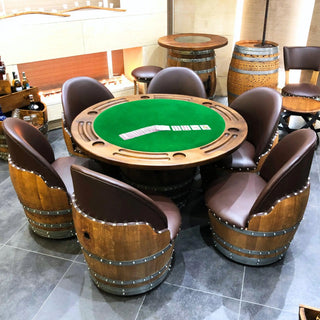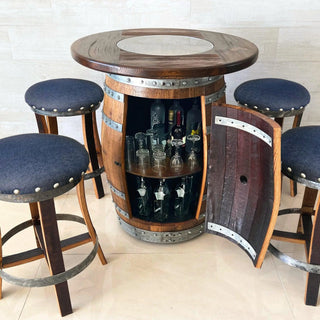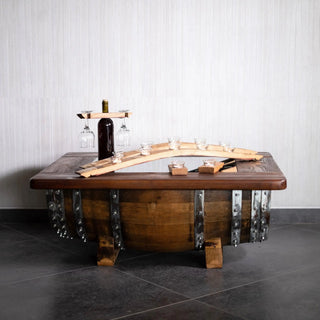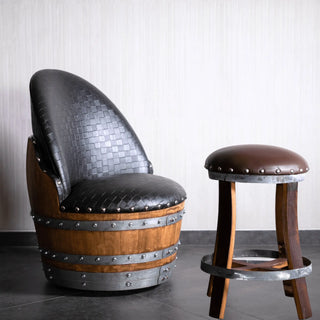How to Hang Barrel Tops Safely on Any Wall Type
Alright — so you’ve finally got your hands on that gorgeous engraved oak barrel top, huh? You unwrap it, run your hand across the grain, catch that faint aroma of old wine or whiskey still hiding in the wood… and then reality hits:
“How the heck am I going to hang this thing without wrecking the wall… or dropping it in the middle of the night?”
I get it. These aren’t lightweight picture frames from the home store. A real barrel top has heft. It’s solid, seasoned oak — the kind of wood that’s been through years of aging in cellars before it ever made its way into your hands.
The good news? Hanging it safely (and beautifully) isn’t rocket science. It just takes the right tools, a little patience, and a healthy respect for both your wall and your wood.
Let’s talk about how to do it right — and how to make sure that piece of history you’re about to hang stays there for decades.
Step 1: Feel the Weight — Literally
Before you even grab a drill, pick up your barrel top. Really feel it.
Notice the solid weight of that oak? That’s what sets it apart from mass-produced décor. But it also means you’ve got to treat it like what it is — a serious piece of wood.
Most engraved barrel heads from Oak Wood Wine Barrels weigh anywhere from 10 to 25 pounds, depending on whether it still has metal hoops. That’s enough to demand sturdy hardware — no flimsy Command strips, no tiny picture nails.
If it’s heavy enough that your arm gets tired holding it for a few seconds, congratulations — you own something that deserves real respect.
Step 2: Pick the Perfect Spot (Where It’ll Actually Shine)
You know that feeling when the light hits the oak just right — that soft, golden glow that brings out every grain and mark? That’s what you want.
Barrel tops look best when they’ve got breathing room. Somewhere they can command attention without feeling crowded. Think:
- Over a home bar or drink cabinet
- Above your dining table
- By your entryway — where guests can’t miss it
- Behind a sofa, where it ties the whole space together
Avoid direct sunlight (oak doesn’t like UV rays any more than your skin does), and if you’re hanging it outdoors, make sure it’s sealed for the weather.
The goal is simple: make it look intentional — not like you ran out of space for other art.
Step 3: Match the Mounting to Your Wall Type
Alright, here’s where things get a little technical — but I promise it’s not boring.
Different walls, different methods. Let’s break it down:
For Drywall (the most common type)
- Use anchored screws or heavy-duty picture hooks rated for at least double your barrel’s weight.
- If you can, find a stud behind the wall — that’s your jackpot.
- Pre-drill gently (no power-drill aggression, please), then screw in your anchors snugly.
Tip: If you hear a hollow sound when you tap the wall, that’s drywall — so anchors are a must.
For Brick or Concrete Walls
- Grab masonry screws or anchor bolts.
- Drill pilot holes with a masonry bit, then tap in your anchors.
- Avoid drilling into the mortar — it’s the soft part between the bricks. You want to hit the brick itself.
This setup looks incredible for outdoor bars, patios, or wine cellars with exposed brick walls. The contrast between red brick and rich oak? Absolutely unbeatable.
For Wood Walls or Paneling
You’ve got it easy, friend. Just use wood screws or a D-ring hanging kit.
If you want the Ferrari of secure hanging, try a French cleat system — two wooden strips that lock together like a puzzle. One goes on the wall, the other on the back of the barrel top. It’s sturdy, simple, and spreads the weight perfectly.
And yes — it makes you look like you really know what you’re doing.
Step 4: Choose the Hanging Style That Fits Your Personality
Let’s be honest — how you hang it is part of the art.
Classic & Clean:
Two D-rings on the back with a sturdy wire between them. Easy, balanced, timeless.
Rustic & Bold:
Use iron chains or metal brackets — they add texture and lean into that old-world charm. I’ve seen a chain-hung barrel head over a bar, and it just oozed vintage vineyard energy.
Minimal & Invisible:
Go with the French cleat. It hides all the hardware, leaving just the oak floating on your wall like it’s meant to be there.
Step 5: Don’t Forget the Details
Before you mount it, add felt or rubber pads on the back corners of the barrel head. It keeps the wall from scuffing and allows just enough airflow so the wood can breathe.
If you’re hanging multiple pieces, don’t cram them together like they’re fighting for space. Give each one a little air — each barrel top deserves to shine on its own.
And most importantly: use a level. You’d be amazed how a slightly tilted piece will drive you crazy every time you walk by. Don’t trust your eyes — they lie.
Step 6: Hanging Outdoors? Treat It Like a Living Thing
Oak is tough — really tough — but it’s still alive in a way. It expands and contracts with the weather, so if you’re hanging it outside:
- Make sure it’s sealed with an exterior-grade finish (Oak Wood Wine Barrels offers outdoor-ready tops).
- Mount it under a covered area if possible — it’ll age beautifully without rotting.
- Clean it gently every few months — a soft cloth, no harsh cleaners.
Outdoor barrel décor has a charm you can’t replicate. Under string lights or beside a fire pit, it feels like a story told in wood.
Step 7: The Final Test — The “Tap and Tug”
After you’ve hung it, give it the tap-and-tug test.
Tap near the top — it should sound firm, not wobbly.
Then give it a gentle tug forward. If it doesn’t move, congrats — you’ve done it right.
Now pour yourself a drink (bonus points if it came from a barrel-aged bottle) and admire that perfect oak circle on your wall.
It’s not just hanging — it’s anchored history.
Why Barrel Tops Deserve This Kind of Care
Because they’re not decorations — they’re artifacts.
Every barrel top started as a living oak tree, then spent years holding wine or whiskey, soaking in aroma and time, before being reborn into a piece of art.
When you hang it, you’re not just putting up a decoration. You’re continuing a legacy — one that’s literally aged to perfection.
And when people walk in and notice it, they won’t just say, “That’s nice.”
They’ll ask where it came from, what it means, and you’ll get to tell them the story.
That’s the kind of décor that never goes out of style.
Why I Always Recommend Oak Wood Wine Barrels
I’ve seen a lot of imitations — but nothing comes close to the real thing.
At Oak Wood Wine Barrels, every barrel top is made from authentic reclaimed oak — the real deal, straight from vineyards and distilleries. Each piece is cleaned, restored, and finished by hand. No two are ever the same, because no two barrels ever lived the same story.
You can literally see the fingerprints of time — wine stains, subtle char marks, faint iron impressions from the hoops that once held them together.
That’s what makes them special. That’s why they deserve to be hung right.
Our Links
- Explore Custom Engraved Barrel Tops
- Shop Wall-Mounted Barrel Décor
- Learn More About Barrel Care & Installation
Relevant Resources
- Hanging Heavy Wall Art Like a Pro
- The Beauty of Reclaimed Oak in Modern Design
- How to Maintain and Protect Wooden Wall Art
⚠️ Disclaimer
This isn’t a step-by-step from a hardware manual — it’s real advice from someone who’s actually hung heavy oak pieces, cursed a few crooked attempts, and figured out how to do it right.
Every Oak Wood Wine Barrels top is handcrafted, meaning no two weigh or balance exactly the same. Always use secure mounting hardware and double-check stability before hanging.
For custom instructions, sealing options, or professional advice, visit OBARREL.COM.
And when it’s finally up — centered, sturdy, glowing in the light — take a second to just look at it. Because that’s not just a piece of oak on your wall.
That’s a slice of history — reclaimed, reimagined, and now, completely yours.




